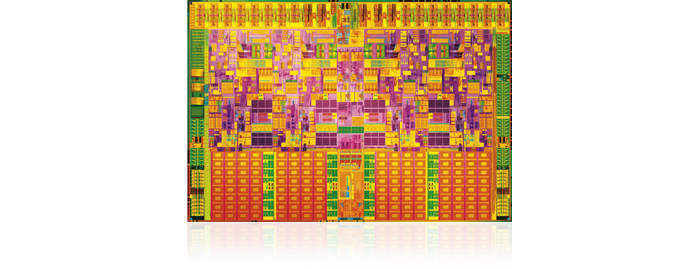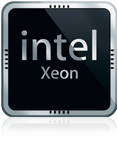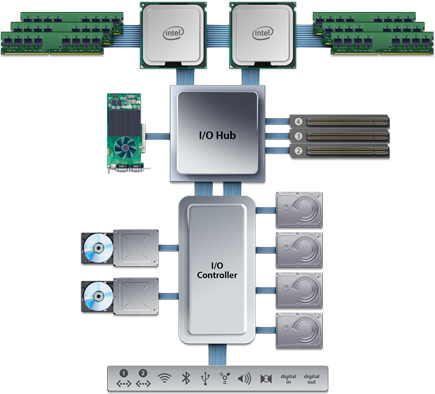

The “Nehalem” advantage.
Many quad-core processors are composed of two separate dies, which means some cached data has to travel outside the processor to get from core to core. That’s an inefficient way to access information. Enter the Quad-Core Intel Xeon “Nehalem” processor. Its single-die, 64-bit architecture makes 8MB of fully shared L3 cache readily available to each of the four processor cores. The result is fast access to cache data and greater application performance. Combine that with the other technological advances and you get a Mac Pro that’s up to 1.9x faster than the previous generation.1

Memory bottlenecks begone.
System memory is often connected to a processor through a separate I/O controller. But each Intel Xeon “Nehalem” processor features an integrated memory controller — another leap forward for workstation system architecture. By connecting memory directly to the processor, the new Mac Pro processors have faster access to data stored in memory and memory latency is reduced by up to 40 percent.
The integrated memory controller, along with fast 1066MHz DDR3 ECC SDRAM, also gives Mac Pro up to a 2.4x increase in memory bandwidth over previous generations.2 More bandwidth allows for more data to be fed to the processor faster, helping each core spend its time processing data, not waiting for information to arrive. And Error Correction Code (ECC) corrects single-bit errors and detects multiple-bit errors automatically. That’s especially important in mission-critical and compute-intensive environments.
Power when (and where) you need it.
The new Mac Pro introduces Turbo Boost: a dynamic performance technology that automatically boosts the processor clock speed based on workload. If you’re using an application that doesn’t need every core, Turbo Boost shuts off the idle cores while simultaneously increasing the speed of the active ones, up to 3.33GHz on a 2.93GHz Mac Pro.
The virtue of virtual cores.
The new Intel Xeon “Nehalem” processors support Hyper-Threading, which allows two threads to run simultaneously on each core. So an 8-core Mac Pro presents 16 virtual cores that are recognised by Mac OS X. Performance is enhanced because Hyper-Threading enables the processor to take better advantage of the execution resources available in each core.
Path of least resistance.
A new bidirectional, point-to-point connection — called QuickPath Interconnect — gives the Intel Xeon “Nehalem” processor quick access to the disk, I/O and other Mac Pro subsystems. In the new 8-core Mac Pro, there’s a QuickPath Interconnect between the two quad-core processors as well. This connection acts as a direct pipeline, so processor-to-processor data doesn’t need to travel to the I/O hub first. It’s another way the new Mac Pro boosts performance across the board.
Powerfully efficient.
Based on an industry-leading 45-nm process technology and combined with improved power management capabilities, the new Intel Xeon “Nehalem” processors are more energy efficient than before. So the Mac Pro is faster than ever, while using less energy when idle.
STREAM. Memory throughput.
CINT2006 Rate and CFP2006 Rate.
Integer and floating-point calculation results.
- Testing conducted by Apple in February 2009 using preproduction Mac Pro 8-core 2.93GHz units and shipping Mac Pro 8-core 3.2GHz units. SPEC® is a registered trademark of the Standard Performance Evaluation Corporation (SPEC); see www.spec.org for more information. Performance tests are conducted using specific computer systems and reflect the approximate performance of Mac Pro.
- Testing conducted by Apple in February 2009 using preproduction Mac Pro 8-core 2.93GHz units and shipping Mac Pro 8-core 3.2GHz units. Systems were configured with 6GB of RAM for Mac Pro 8-core 2.93GHz and 8GB of RAM for Mac Pro 8-core 3.2GHz. Results are based on the STREAM v. 5.8 benchmark (www.cs.virginia.edu/stream/ref.html) using OMP support for multiprocessor-compiled builds. Performance tests are conducted using specific computer systems and reflect the approximate performance of Mac Pro.